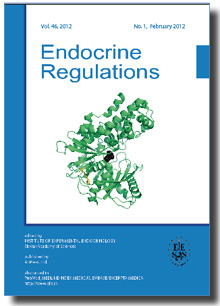Journal info
|
||
Select Journal
Journals
Bratislava Medical Journal Ekologia - Ecology Endocrine Regulations 2015 2014 2013 2012 2011 2010 2009 2008 2007 2006 2005 2004 2003 General Physiology and Biophysics Neoplasma Acta Virologica Studia Psychologica Cardiology Letters Psychológia a patopsych. dieťaťa Kovove Materialy-Metallic Materials Slovenská hudba 2025Webshop Cart
Your Cart is currently empty.
Info: Your browser does not accept cookies. To put products into your cart and purchase them you need to enable cookies.
Endocrine Regulations Vol.46, No.2, p.51-59, 2012 |
||
| Title: Blood testosterone in middle aged males heavily exposed to endocrine disruptors is decreasing more with HCB and p,p’-DDE related to BMI and lipids, but not with Σ15PCBs | ||
| Author: P. Langer, A. Kocan, B. Drobna, K. Susienkova, Z. Radikova, M. Huckova, R. Imrich , I. Klimes | ||
| Abstract: Objective. This work was aimed to evaluate the fundamental relations between the blood levels of testosterone (TEST) and persistent organochlorinated pollutants (POPs) related to body mass index (BMI) and blood lipids in a cohort of heavily exposed males from Eastern Slovakia. Methods. In 429 middle aged (41-55 years) males heavily exposed to POPs the levels of 15 polychlorinated biphenyl congeners (Σ15PCBs), hexachlorobenzene (HCB), and dichlorodiethyl-dichloroethylene (p,p’-DDE) were measured by gas chromatography/mass spectrometry and the total testosterone (TEST) by electrochemiluminiscent immunoassay. Results. After classifying the values of BMI, TEST, HCB, p,p’-DDE, and Σ15PCBs in quintiles and evaluating mutual interrelations of individual quintile counts in pairs of variables with chi-square, statistically significant interrelation was found for BMI/TEST (<0.0001) and HCB/TEST (p<0.001), but not for p,p’-DDE/TEST (p<0.6036) and Σ15PCBs/TEST (p<0.3246). Moreover, highly significant negative correlation was found between HCB and TEST by means of both Pearson (p<0.01) and Spearman rank correlations (p<0.0001). However, similar correlations performed between p,p’-DDE and Σ15PCBs did not reveal statistical significance. Finally, highly significant positive correlations were found between HCB and BMI, age, total lipids, and triglycerides. However, these correlations were less significant for p,p’-DDE and not significant or even negligibly negative for Σ15PCBs. In contrast, correlations of TEST with BMI and lipid fractions were significantly negative. Conclusion. It appears that HCB might play a role in a decrease of TEST in males with relatively narrow age range of males highly exposed to POPs. Highly significant positive correlation of HCB with BMI and blood lipids points out the role of BMI as an imaginary compartment closely related to the total body fat mass and representing a depot of POPs which is closely related to the level of POPs and lipids in blood. However, the differences in the affinity of individual POPs to BMI and blood lipids as well as the mechanism of their different relation to blood TEST levels remain to be still explained. |
||
| Keywords: testosterone, 15 PCB congeners, HCB, p,p’-DDE, BMI, adult males | ||
| Year: 2012, Volume: 46, Issue: 2 | Page From: 51, Page To: 59 | |
| doi:10.4149/endo_2012_02_51 |
||
|
Price:
18.00 €
|
||
|
|
||

